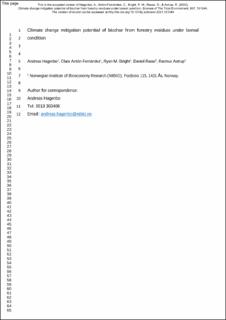| dc.contributor.author | Hagenbo, Andreas | |
| dc.contributor.author | Antón-Fernández, Clara | |
| dc.contributor.author | Bright, Ryan M. | |
| dc.contributor.author | Rasse, Daniel | |
| dc.contributor.author | Astrup, Rasmus Andreas | |
| dc.date.accessioned | 2021-12-17T10:41:00Z | |
| dc.date.available | 2021-12-17T10:41:00Z | |
| dc.date.created | 2021-12-06T09:20:51Z | |
| dc.date.issued | 2021-10-18 | |
| dc.identifier.citation | Science of the Total Environment. 2021, . | en_US |
| dc.identifier.issn | 0048-9697 | |
| dc.identifier.uri | https://hdl.handle.net/11250/2834882 | |
| dc.description.abstract | Forest harvest residue is a low-competitive biomass feedstock that is usually left to decay on site after forestry operations. Its removal and pyrolytic conversion to biochar is seen as an opportunity to reduce terrestrial CO2 emissions and mitigate climate change. The mitigation effect of biochar is, however, ultimately dependent on the availability of the biomass feedstock, thus CO2 removal of biochar needs to be assessed in relation to the capacity to supply biochar systems with biomass feedstocks over prolonged time scales, relevant for climate mitigation. In the present study we used an assembly of empirical models to forecast the effects of harvest residue removal on soil C storage and the technical capacity of biochar to mitigate national-scale emissions over the century, using Norway as a case study for boreal conditions. We estimate the mitigation potential to vary between 0.41 and 0.78 Tg CO2 equivalents yr−1, of which 79% could be attributed to increased soil C stock, and 21% to the coproduction of bioenergy. These values correspond to 9–17% of the emissions of the Norwegian agricultural sector and to 0.8–1.5% of the total national emission. This illustrates that deployment of biochar from forest harvest residues in countries with a large forestry sector, relative to economy and population size, is likely to have a relatively small contribution to national emission reduction targets but may have a large effect on agricultural emission and commitments. Strategies for biochar deployment need to consider that biochar's mitigation effect is limited by the feedstock supply which needs to be critically assessed. | en_US |
| dc.language.iso | eng | en_US |
| dc.publisher | Elsevier B.V. | en_US |
| dc.rights | Attribution-NonCommercial-NoDerivatives 4.0 Internasjonal | * |
| dc.rights.uri | http://creativecommons.org/licenses/by-nc-nd/4.0/deed.no | * |
| dc.title | Climate change mitigation potential of biochar from forestry residues under boreal condition | en_US |
| dc.type | Peer reviewed | en_US |
| dc.type | Journal article | en_US |
| dc.description.version | acceptedVersion | en_US |
| dc.rights.holder | © 2021 Elsevier B.V. | en_US |
| dc.source.volume | 807 | en_US |
| dc.source.journal | Science of the Total Environment | en_US |
| dc.source.issue | 3 | en_US |
| dc.identifier.doi | 10.1016/j.scitotenv.2021.151044 | |
| dc.identifier.cristin | 1964891 | |
| dc.relation.project | Norges forskningsråd: 281113 | en_US |
| dc.source.articlenumber | 151044 | en_US |
| cristin.ispublished | true | |
| cristin.fulltext | postprint | |
| cristin.qualitycode | 2 | |

